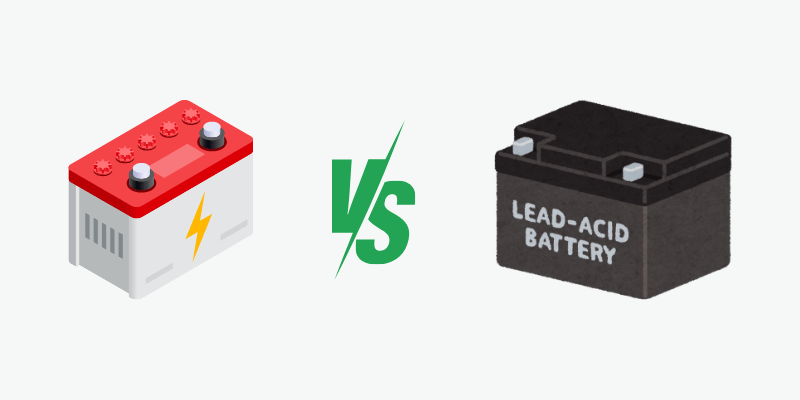Key Takeaway:
- Choose lithium-ion for efficiency, longevity, and portability; lead-acid for initial cost savings and cold weather performance.
Need a choice between lithium and lead acid batteries? You’re in the right place.
They are both widely used, but they serve different applications and come with their own advantages and disadvantages.
Let’s break this down further.
Energy Density
Ever wonder how much energy can be stored in a given space in these batteries? This is measured by energy density.
Lithium-ion batteries take the lead, giving you around 50-260 Wh/kg, whereas lead-acid batteries usually offer between 30-50 Wh/kg.
Weight
Lithium batteries are significantly lighter than their lead-acid counterparts, weighing up to 60% less. Imagine the mobility and portability!
Efficiency
Moving to efficiency, lithium-ion batteries again take the lead.
Their charge and discharge efficiency often exceed 95% compared to the 70-85% range of lead acid batteries.
Isn’t consistency and reliability something you all look for?
Charging Time
Now, how quickly do these batteries charge?
Lithium ion batteries shine here too, needing just 3-5 hours to fully charge.
Their lead acid counterparts, however, need quite a bit more time, taking 8-12 hours for a full charge.
Discharge Rate and Depth
The discharge depth of a battery indicates how much energy can be depleted without damaging its cells.
Under normal usage, a lithium-ion battery can utilize over 85% of its capacity.
In contrast, a lead-acid battery should not discharge beyond 50% to preserve its lifespan.
High Temperature Performance
Lithium batteries outperform SLA (sealed lead acid) batteries at high temperatures, operating effectively to 60°C compared to SLA’s 50°C.
At 55°C, lithium lasts twice as long as SLA at room temperature.
Cold Temperature Performance
Cold temperatures can significantly reduce battery capacity.
When evaluating a battery for cold use, consider charging and discharging.
A lithium battery won’t charge below 32°F, while an SLA can accept low current charges at low temperatures.
Conversely, lithium batteries have a higher discharge capacity in the cold than SLA. Lithium batteries don’t need to be overdesigned for cold, but charging might be a limitation. At 0°F, lithium discharges at 70% of its capacity, while SLA is at 45%.
When charging in the cold, consider the lithium battery’s state. If recently discharged, it may retain enough heat to accept a charge. If cooled down, it might not charge below 32°F.
Battery Lifespan
There are several types of lithium batteries. On average, a lithium battery can exceed 1,000 charge cycles (LiFePO4 batteries can even last over 3,000 cycles with proper maintance).
Unfortunately, lead acid batteries are less durable, lasting only 500 to 1000 charge cycles in general.
More cycles = less frequent replacements = less cost.
Isn’t that music to anyone’s ears?
Storage
For storage, lithium stays ahead.
They’re easier to store and need less maintenance than the lead acid batteries.
Cost
Lithium batteries may cost more upfront, but they last longer and perform better, potentially saving you money in the long run.
Meanwhile, lead-acid batteries are cheaper initially but often need to be replaced more frequently, which can add up over time.
Lithium Batteries VS. Lead-Acid Batteries Comparison
| Feature | Lithium Batteries | Lead-Acid Batteries |
|---|---|---|
| Energy Density (Wh/kg) | 120-180 | 28-40 |
| Weight | Up to 60% lighter | Heavier |
| Efficiency (%) | Over 95% | 70-85% |
| Charging Time (hours) | 3-5 | 8-12 |
| Discharge Rate and Depth | Over 85% capacity | Should not exceed 50% |
| High Temperature Performance (°C) | Up to 60°C with thermal management | Up to 50°C |
| Cold Temperature Performance | Discharges at 70% at 0°F, charges below 32°F with limitations | Accepts low current charges at low temperatures, discharges at 45% at 0°F |
| Battery Lifespan (charge cycles) | Over 1,000 | 300-500 |
| Storage and Maintenance | Easier to store, less maintenance | More maintenance required |
| Cost | More upfront, potentially cost-effective in the long run | Cheaper upfront, but may need more frequent replacements |
Conclusion
Ultimately, the choice between lithium and lead-acid batteries depends on your specific needs.
Lithium batteries excel in lifespan, weight, and charging time, making them ideal for high-efficiency applications.
Conversely, lead-acid batteries perform well in extreme temperatures and offer an initial cost advantage.
Understanding these differences can guide you in making the best decision for your requirements. So, which battery will power your next project?
Related Articles:

